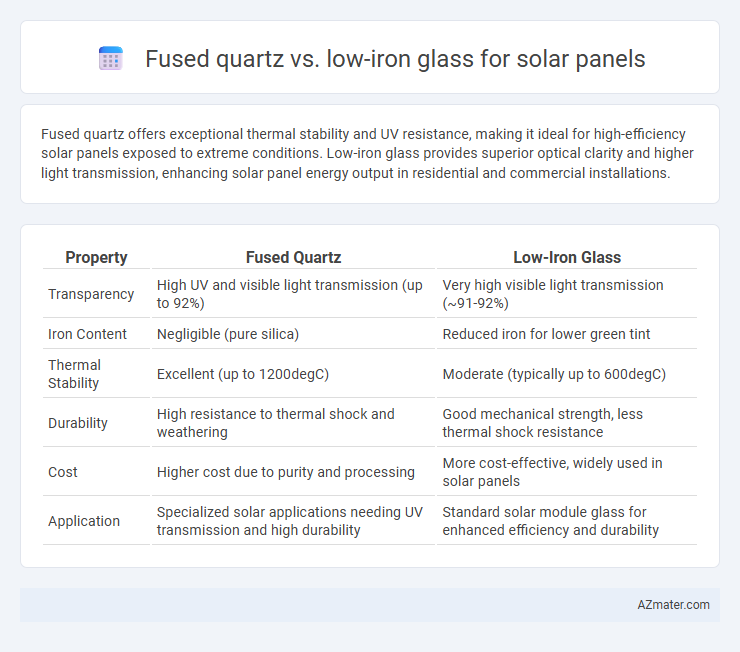Fused quartz offers exceptional thermal stability and UV resistance, making it ideal for high-efficiency solar panels exposed to extreme conditions. Low-iron glass provides superior optical clarity and higher light transmission, enhancing solar panel energy output in residential and commercial installations.
Table of Comparison
| Property | Fused Quartz | Low-Iron Glass |
|---|---|---|
| Transparency | High UV and visible light transmission (up to 92%) | Very high visible light transmission (~91-92%) |
| Iron Content | Negligible (pure silica) | Reduced iron for lower green tint |
| Thermal Stability | Excellent (up to 1200degC) | Moderate (typically up to 600degC) |
| Durability | High resistance to thermal shock and weathering | Good mechanical strength, less thermal shock resistance |
| Cost | Higher cost due to purity and processing | More cost-effective, widely used in solar panels |
| Application | Specialized solar applications needing UV transmission and high durability | Standard solar module glass for enhanced efficiency and durability |
Introduction: Fused Quartz vs Low-Iron Glass in Solar Panel Technology
Fused quartz offers exceptional thermal stability and high UV transmittance, making it ideal for solar panel applications requiring durability and efficient light transmission. Low-iron glass provides superior visible light transparency and cost-effectiveness, enhancing solar cell performance by reducing light absorption losses. Comparing these materials highlights critical factors such as optical clarity, thermal expansion, and manufacturing costs that influence solar panel efficiency and longevity.
Material Composition and Structure
Fused quartz consists primarily of pure silicon dioxide (SiO2) in an amorphous, non-crystalline structure, offering exceptional thermal stability and high transmission of ultraviolet light, making it ideal for solar panel covers. Low-iron glass, composed mainly of silica with reduced iron oxide content, enhances visible light transmittance by minimizing green tint and improving optical clarity while maintaining a crystalline structure. The superior purity and molecular network of fused quartz provide better resistance to thermal shock and ultraviolet degradation compared to low-iron glass, which is more cost-effective but less durable under extreme environmental conditions.
Optical Transmittance and Light Transmission
Fused quartz offers superior optical transmittance, exceeding 92% across the solar spectrum, making it highly efficient for solar panel applications by maximizing light transmission. Low-iron glass, designed to reduce iron content, typically achieves optical transmittance around 91-92%, enhancing light transmission compared to standard glass but still marginally less than fused quartz. The higher purity and minimal absorption characteristics of fused quartz enable better performance in converting sunlight to electricity, especially in applications requiring long-term durability and consistency.
Thermal Stability and Resistance
Fused quartz offers superior thermal stability with a high melting point around 1,650degC, making it highly resistant to thermal shock compared to low-iron glass, which typically withstands temperatures only up to about 600degC. Its exceptional resistance to thermal expansion ensures minimal deformation under rapid temperature fluctuations, crucial for solar panel longevity in extreme climates. Low-iron glass, while offering enhanced light transmission, is more susceptible to cracking and degradation when exposed to intense heat and thermal cycling.
Mechanical Strength and Durability
Fused quartz exhibits superior mechanical strength and exceptional thermal stability compared to low-iron glass, making it highly resistant to mechanical stress and temperature fluctuations in solar panel applications. Low-iron glass offers high transparency but is more prone to scratching and mechanical damage under harsh environmental conditions. The enhanced durability of fused quartz ensures longer lifespan and minimal maintenance, crucial for solar panels exposed to extreme weather and physical impacts.
Impact on Solar Panel Efficiency
Fused quartz offers superior transmission of ultraviolet light and exceptional thermal stability, enhancing solar panel efficiency by maximizing solar energy absorption and minimizing heat-induced degradation. Low-iron glass provides high visible light transmission with reduced iron content, increasing energy yield by allowing more sunlight to reach photovoltaic cells. In comparison, fused quartz excels in durability and UV transmission, making it ideal for high-performance solar panels, while low-iron glass balances cost-effectiveness with improved light transmittance.
Cost Comparison and Availability
Fused quartz typically incurs higher costs due to its superior thermal stability and purity, making it less common in large-scale solar panel manufacturing compared to low-iron glass. Low-iron glass, widely available and produced at scale, offers a cost-effective solution with adequate transparency for solar applications though it may exhibit slightly lower durability in extreme conditions. The cost differential and accessibility strongly influence the choice, favoring low-iron glass for commercial solar panels while fused quartz is reserved for high-performance or specialized photovoltaic systems.
Environmental Considerations
Fused quartz offers superior thermal stability and UV resistance, reducing degradation and extending the lifespan of solar panels, which results in lower environmental impact through decreased replacement frequency. Low-iron glass enhances solar energy transmission but requires more energy-intensive production processes, contributing to a higher carbon footprint compared to fused quartz. Choosing fused quartz can lead to better sustainability in solar panel manufacturing due to its durability and reduced ecological cost over the lifecycle of the panel.
Applications in Photovoltaic Systems
Fused quartz offers superior thermal stability and high UV transmittance, making it ideal for concentrated photovoltaic systems requiring durability under extreme conditions. Low-iron glass provides excellent clarity and high visible light transmittance, enhancing the overall efficiency of conventional photovoltaic modules. Both materials are critical in photovoltaic applications, with fused quartz preferred for high-temperature and high-radiation environments and low-iron glass optimized for maximizing sunlight absorption in standard solar panels.
Conclusion: Choosing Between Fused Quartz and Low-Iron Glass for Solar Panels
Fused quartz offers superior thermal stability and high UV transmittance, making it ideal for long-term durability in harsh environments. Low-iron glass provides excellent light transmission and lower cost, enhancing panel efficiency while remaining economically viable. Select fused quartz for extreme temperature or UV exposure conditions and low-iron glass for optimized performance in standard solar installations.

Infographic: Fused quartz vs Low-iron glass for Solar panel
 azmater.com
azmater.com